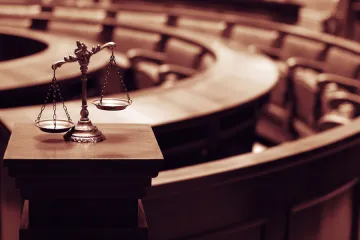CNA Staff, Aug 7, 2024 / 06:00 am
A recent U.S. Supreme Court decision on bankruptcy law will “absolutely” have a significant effect on U.S. Church abuse lawsuits, one legal expert says, with the highest court potentially opening up individual Catholic parishes and schools to legal action.
In its June 27 decision in Harrington v. Purdue Pharma L.P., the Supreme Court held that U.S. bankruptcy law “does not authorize a release and injunction that, as part of a plan of reorganization under Chapter 11, effectively seek to discharge claims against a non-debtor without the consent of affected claimants,” according to SCOTUSblog.
Untangling the complexities of that ruling requires some knowledge of U.S. bankruptcy law, says John Czarnetzky, the dean and CEO of Ave Maria School of Law in Naples, Florida.
“The most ancient type of bankruptcy is liquidation — a debtor files, sells all of its assets in bankruptcy court, and distributes that money to creditors,” said Czarnetzky, who has taught bankruptcy law and litigated it in private practice.
In contrast, he said, in a U.S. Chapter 11 bankruptcy reorganization, “a debtor files a bankruptcy, and at the end of the case gets a discharge. The debtor also gets to keep its assets.”
In such cases, he said, “the debtor must propose a plan which creditors get to vote on that provides those creditors at least what they would receive in a liquidation.”
“The idea is that if that test is met, it’s a win-win — the corporation continues in business, saving jobs, local business, etc., and creditors are not worse than if the debtor liquidated,” he said.
Yet creditors who disagree with such proceedings, Czarnetzky said, often find that they “have had their rights to sue for what they are owed taken away without their consent.”
“The Supreme Court in the case agreed with them, and held that the bankruptcy code has no provisions that permit this,” he said.
Okay, but what does it mean for Church abuse lawsuits?
The decision “absolutely” will affect how Catholic sex abuse lawsuits proceed in the U.S., Czarnetzky said, though “precisely what those effects will be is uncertain at the moment.”
More than two dozen U.S. dioceses have entered into bankruptcy proceedings, the vast majority in the past decade, in response to voluminous lawsuits filed by alleged victims of clerical sex abuse. Many dioceses have cited the high cost of settling abuse claims as a major factor in the decision to declare bankruptcy.
Czarnetzky said that in such proceedings, funding for the settlements comes “from local parishes, schools, and all other organizations that are part of dioceses.”
“Those entities pony up the money to fund the plan, but they receive a release of their liability for the torts [a civil wrong that causes a claimant to suffer loss or harm] that led to the insolvency of the diocese,” he said.
Under the Supreme Court’s ruling, Czarnetzky said, “each individual parish, school, and any other diocesan organization potentially could be sued.”
“If that happens, the complexity of the financial reckoning in the child molestation crisis in the Church becomes many, many times more complex,” he said.
(Story continues below)
“To give one example, parishes are often covered under diocesan insurance policies for these matters,” he said. “If all the parishes and the diocese are all in bankruptcy proceedings, how are those insurance policies apportioned?”
In such proceedings, he said, the insurance policies will be “property” in each of the separate bankruptcy cases.
The court’s ruling, he said, “will undoubtedly present complex issues in diocesan Chapter 11 cases,” so much so that a diocese might in theory opt for liquidation rather than reorganization.
“If those issues are so complex that the costs of the litigation becomes too high, the alternative for a diocese might theoretically become the liquidation of the diocesan assets, including even those of individual parishes and diocesan organizations,” he said.
“This is a remote possibility at the moment, but this decision brings it into play when it has not been until this decision.”
Left uncertain, he said, is whether or not potential abuse victims will get more under the Supreme Court’s new policy than they would get through the prior Chapter 11 process.
Outside of bankruptcy court, Czarnetzky noted, payouts to tort victims are awarded on a first-come, first-served basis, “until the money runs out.”
“At that point, the remaining creditors get nothing,” he said.
“If bankruptcy in Chapter 11 is not viable … and dioceses don’t file liquidation bankruptcies, it’s a pure race to the courthouse,” he said. “If they file liquidation bankruptcies, then that likely means liquidations of the parishes, schools, etc., and who knows what the return to victims will be of those multiple bankruptcies.”
It’s “hard to see that it would be more than it has been from the centralized diocesan Chapter 11 model,” he said.
“This is a risk in diocesan bankruptcies,” he said. “With no way to receive releases, individual parishes, schools, etc. would be forced to file their own bankruptcy cases. Victims would have to deal with multiple bankruptcy cases, each of which would have its own administrative expenses eating up the assets of the debtor.”
“One way or another, the tort victims would likely be dealing with more than one bankruptcy case, rather than one centralized proceeding against the diocese,” he said. “Will they receive more than they are likely to receive now? Not likely, but very difficult to predict.”
Czarnetzky said the use of the U.S. bankruptcy code to handle the problem of mass torts potentially has been upended by this decision.
The case “injects significant uncertainty, and hence complexity, in Chapter 11 reorganization practice where mass tort liability is the impetus for the bankruptcy filing,” he said. “Obviously, diocesan cases are precisely that model.”






